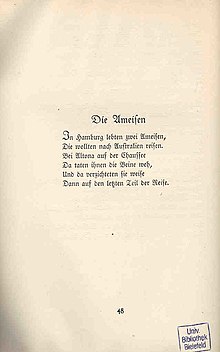The ants (Ringelnatz)

The ants is the title of a poem by Joachim Ringelnatz (1883–1934). It was first published in 1912. Since 2014 there has been a sculpture dedicated to the poem in Hamburg-Altona with the two title ants in bronze .
The poem
Two ants lived in Hamburg.
They wanted to travel to Australia.
At Altona on the Chaussee
their legs ached,
and then they wisely
renounced the last part of the journey.
That's how you often want to, but you can't,
and then you tend to do without.
Joachim Ringelnatz: The Complete Works in Seven Volumes. Volume 1: Gedichte, Zurich 1994, pp. 65–66
Explanations
Content and form

The poem The Ants tells in verse a fable about not having big plans. Two ants, who want to wander halfway around the world, give up their plan in the next town because of pain. Around 1912, when Ringelnatz published the poem for the first time, the neighboring Holstein city of Altona had long since merged with the city of Hamburg in terms of urban planning : you could change from Hamburg to Große Freiheit in Altona on the Reeperbahn by crossing the street.
The Knittelverse have a regular meter, namely a four-part iambus . In the first verse the fourth elevation shifts the emphasis on the word "ant" from the correct first syllable on the second syllable, and the fact is stressed syllable in a reduction: instead of A to A titmouse mei read sen. The couples alternately close in a so-called female and male cadence .
Publications

Ringelnatz published the poem Die Ameisen for the first time under his real name Hans Bötticher in 1912 in the volume of poetry Die Schnupftabaksdose. Stupidity in verse and pictures . It appeared several times during his lifetime, the last time in 1933, without the two closing verses with morals, which were only added in posthumous editions. Furthermore, in the second publication of the poem in Kuttel Daddeldu (published in several editions in the 1920s) , Ringelnatz replaced the adverb “for” at the beginning of the sixth verse with “then”. The poem appears today in numerous anthologies and volumes of poetry, also in school books, sometimes with and sometimes without the two closing verses, and "then" and "then" also vary. The Zurich seven-volume edition of Joachim Ringelnatz's complete works, published in 1994, followed its first publication in 1912: the two moral verses are included, and the sixth verse begins again with the original, but later modified, “for”.
illustration
During Ringelnatz's lifetime, the poem was only illustrated in its first publication in 1912. Richard Seewald (1889–1976) put the distance from a city silhouette above, in which the two ants crawl with walking sticks from Hamburg to Altona, to the also roughly outlined antipodal continent below with an indicated division of states as a lapidary dashed line curved from top to bottom . At the very top, the silhouette ends in a short double line that leads out of a suggested city gate and indicates the distance covered at the end; the subsequent dashed line represents the route dreamed up by the ants but not completed.
The sculpture
On behalf of the Alfred Toepfer Foundation FVS , the North German sculptor Peter Schröder (* 1947) made a larger-than-life-size bronze sculpture of two ants. The two insects crawling behind the other on a plate around the top of a pedestal made of granite is mounted. On the granite plinth at floor level is a 150-year-old copper plate from a church roof. The poem is engraved on it, without the last two verses with morality and with “then” in the sixth verse. The sculpture was set up in May 2014 on the corner of Liebermannstrasse and Elbchaussee ( Lage ).
In the same year and in succession, the bronze ants were repeatedly damaged or stolen in whole or in part, probably also by metal thieves .
literature
- Nils Büttner: Ringelnatz and his illustrators . In: Ringelnatz! A poet paints his world . Edited by Frank Möbus, Friederike Schmidt-Möbus, Frank Woesthoff, Indina Woesthoff. Wallstein: Göttingen 2000, pp. 109–117 ISBN 3-89244-337-8 ( online )
- Joachim Ringelnatz: The Complete Works in Seven Volumes . Edited by Walter Pape . Volume 1: Poems 1 . Volume 2: Poems 2 . Volume 3: Dramas . Volume 4: Stories . Volume 5: Mixed Prose . Volume 6: My life until the war . Volume 7: As a Mariner in War . Diogenes, Zurich 1994, ISBN 978-3-257-06040-9
Web links
Individual evidence
- ↑ Online via Zeno.org.
- ^ Map of Hamburg and Altona 1890
- ↑ Tonbeugung (with lyric moon , accessed on September 30, 2020)
- ↑ The snuffbox. Dullness in verses and pictures by Hans Boetticher and Richard Seewald . Munich: R. Piper, 1912, p. 5 ( online ); Wikisource: The Snuffbox (anthology)
- ↑ Joachim Ringelnatz, 103 poems . Rowohlt, Berlin 1933, p. 32
- ↑ For example in Joachim Ringelnatz: Kuttel Daddeldu . Kurt Wolff, Munich 1923, p. 48
- ↑ The city of Altona never had a city wall; the wall around the city of Hamburg and its ramparts had been dismantled since the middle of the 19th century.
- ↑ Joachim Ringelnatz: Die Schnupftabaksdose , 1912, p. 5 ( archive.org , accessed on September 30, 2020); see: Nils Büttner: Ringelnatz und seine Illustratoren (2000), pp. 109–110
- ↑ Peter Schröder: The ants (from: kunst @ sh , accessed on September 30, 2020)
- ↑ Kulturkarte.de/hamburg (accessed on September 30, 2020)
- ↑ Two Ringelnatz ants for the Elbchaussee ( welt.de , May 9, 2014, accessed September 30, 2020)
- ↑ Bergedorfer Zeitung on August 1, 2014: Thieves mutilate the "ants of Altona" (accessed on September 30, 2020); HafenNewsHamburg on May 14, 2017: The ants from Elbchaussee are gone (accessed September 30, 2020); Hamburger Morgenpost on September 27, 2017: Filed anonymously: Stolen bronze ants reappeared (accessed on September 30, 2020)




